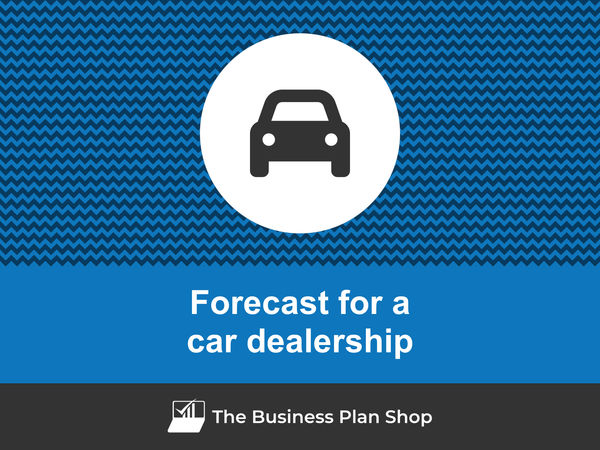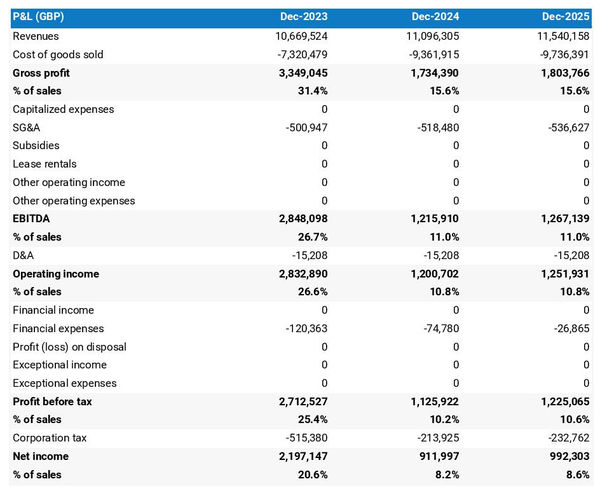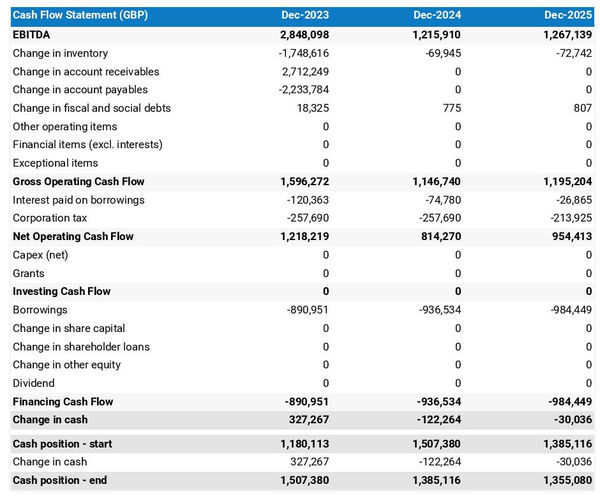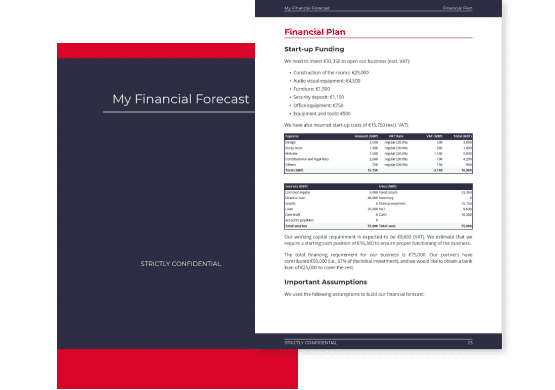How to create a financial forecast for a car dealership?

If you are serious about keeping visibility on your future cash flows, then you need to build and maintain a financial forecast for your car dealership.
Putting together a car dealership financial forecast may sound complex, but don’t worry, with the right tool, it’s easier than it looks, and The Business Plan Shop is here to guide you.
In this practical guide, we'll cover everything you need to know about building financial projections for your car dealership.
We will start by looking at why they are key, what information is needed, what a forecast looks like once completed, and what solutions you can use to create yours.
Let's dive in!
Why create and maintain a financial forecast for a car dealership?
In order to prosper, your business needs to have visibility on what lies ahead and the right financial resources to grow. This is where having a financial forecast for your car dealership becomes handy.
Creating a car dealership financial forecast forces you to take stock of where your business stands and where you want it to go.
Once you have clarity on the destination, you will need to draw up a plan to get there and assess what it means in terms of future profitability and cash flows for your car dealership.
Having this clear plan in place will give you the confidence needed to move forward with your business’s development.
Having an up-to-date financial forecast for a car dealership is also useful if your trading environment worsens, as the forecast enables you to adjust to your new market conditions and anticipate any potential cash shortfall.
Finally, your car dealership's financial projections will also help you secure financing, as banks and investors alike will want to see accurate projections before agreeing to finance your business.
Need a solid financial forecast?
The Business Plan Shop does the maths for you. Simply enter your revenues, costs and investments. Click save and our online tool builds a three-way forecast for you instantly.

What information is used as input to build a car dealership financial forecast?
A car dealership's financial forecast is only as good as the inputs used to build it.
If you are creating (or updating) the forecast of an existing car dealership, then you mostly need your accounting information, key historical operating non-financial data, and your team’s input on what to expect for the coming years.
If you are building financial projections for a car dealership startup, you will need to have done your research and have a clear picture of your competitive environment and go-to-market strategy so that you can forecast sales accurately.
For a new venture, you will also need a precise list of the resources needed to keep the car dealership running on a day-to-day basis and a list of the equipment and expenditures required to start the business (more on that later).
Let's now take a closer look at the elements that make up your car dealership's financial forecast.
The sales forecast for a car dealership
The sales forecast, also called topline projection, is normally where you will start when building your car dealership financial forecast.
Creating a coherent sales projection boils down to estimating two key drivers:
- The average price
- The number of monthly transactions
To do this, you will need to rely on historical data (for an existing business), market research data (for both new and existing car dealerships), and consider the elements below:
- Consumer demand for fuel-efficient vehicles (e.g. electric or hybrid cars) may increase, resulting in higher average prices and potentially lower number of monthly transactions as these vehicles tend to be more expensive.
- The availability of attractive financing options (e.g. 0% APR or cashback offers) may attract more customers and increase the number of monthly transactions, but could also result in lower average prices as customers may negotiate for better deals.
- The introduction of new models or updates to existing models (e.g. a new sports car or a facelift for a popular sedan) may generate buzz and attract more customers, potentially increasing both average prices and number of monthly transactions.
- Fluctuations in the economy (e.g. a recession or a boom period) may affect consumer confidence and purchasing power, resulting in lower or higher average prices and number of monthly transactions.
- The availability of reliable and affordable maintenance and repair services (e.g. partnerships with trusted mechanics or offering discounted service packages) may attract customers and result in higher number of monthly transactions, but could also lead to lower average prices as customers may negotiate for bundled deals.
After the sales forecast comes the operating expenses budget, which we will now look into in more detail.
Need inspiration for your business plan?
The Business Plan Shop has dozens of business plan templates that you can use to get a clear idea of what a complete business plan looks like.

The operating expenses for a car dealership
The next step is to estimate the costs you’ll have to incur to operate your car dealership.
These will vary based on where your business is located, and its overall size (level of sales, personnel, etc.).
But your car dealership's operating expenses should normally include the following items:
- Staff Costs: This includes salaries, wages, and benefits for all employees working at the car dealership, including salespeople, mechanics, and administrative staff.
- Accountancy Fees: You will need to hire an accountant to handle your dealership's financial records, tax filings, and other accounting tasks.
- Insurance Costs: You will need insurance to protect your dealership from potential risks such as accidents, property damage, and liability claims.
- Software Licences: To efficiently manage your inventory, sales, and other operations, you will need to invest in software licenses for dealership management systems, accounting software, and other necessary tools.
- Banking Fees: Your dealership will have various banking needs, including checking and savings accounts, credit card processing, and loans, which will come with associated fees.
- Advertising and Marketing: To attract customers and promote your dealership, you will have to spend money on advertising and marketing efforts, such as television and radio commercials, digital marketing, and print ads.
- Rent or Mortgage: If you do not own the property where your dealership is located, you will have to pay rent. If you have purchased the property, you will have to cover mortgage payments.
- Utilities: Your dealership will have ongoing expenses for utilities such as electricity, water, and gas to keep the lights on and the building comfortable for customers and employees.
- Maintenance and Repairs: As a car dealership, you will need to keep your inventory in top condition, which will require regular maintenance and repairs, including detailing, oil changes, and major repairs.
- Inventory Costs: You will have to purchase new vehicles from manufacturers, which will require upfront costs. You will also have ongoing costs to maintain a sufficient inventory of popular models.
- Taxes and Licenses: As a business owner, you will have to pay various taxes, including income tax, sales tax, and property tax. You will also need to obtain and renew necessary licenses and permits to operate your dealership.
- Training and Development: Your employees will need to stay up-to-date with the latest industry trends, technology, and sales techniques. You will have to cover the costs of training and development programs to keep your staff knowledgeable and competitive.
- Office Supplies and Equipment: To run your dealership smoothly, you will need to purchase office supplies, such as paper, ink, and pens, as well as equipment like computers, printers, and phones.
- Travel Expenses: As a car dealership, you may need to travel to attend industry events, meet with manufacturers, or transport vehicles. You will have to cover the costs of travel, including airfare, lodging, and meals.
- Legal Fees: You may need to seek legal advice or representation for various reasons, such as negotiating contracts, resolving disputes, or complying with laws and regulations. You will have to pay for legal services.
This list is not exhaustive by any means, and will need to be tailored to your car dealership's specific circumstances.
What investments are needed to start or grow a car dealership?
Once you have an idea of how much sales you could achieve and what it will cost to run your car dealership, it is time to look into the equipment required to launch or expand the activity.
For a car dealership, capital expenditures and initial working capital items could include:
- Inventory: This includes the cost of purchasing new vehicles to sell in your dealership. It also includes the cost of financing the inventory, such as interest and fees.
- Building and property: This includes the cost of purchasing or leasing the physical space for your dealership, as well as any necessary renovations or repairs.
- Equipment: This includes the cost of purchasing or leasing equipment such as car lifts, diagnostic tools, and office furniture for your dealership.
- Technology: This includes the cost of purchasing or upgrading computer systems, software, and other technology tools necessary for running your dealership, such as a CRM system or accounting software.
- Vehicles for dealership use: This includes the cost of purchasing or leasing vehicles for your dealership's use, such as company cars or shuttle vehicles for customer service.
Again, this list will need to be adjusted according to the specificities of your car dealership.
Need a convincing business plan?
The Business Plan Shop makes it easy to create a financial forecast to assess the potential profitability of your projects, and write a business plan that’ll wow investors.

The financing plan of your car dealership
The next step in the creation of your financial forecast for your car dealership is to think about how you might finance your business.
You will have to assess how much capital will come from shareholders (equity) and how much can be secured through banks.
Bank loans will have to be modelled so that you can separate the interest expenses from the repayments of principal, and include all this data in your forecast.
Issuing share capital and obtaining a bank loan are two of the most common ways that entrepreneurs finance their businesses.
What tables compose the financial plan for a car dealership?
Now let's have a look at the main output tables of your car dealership's financial forecast.
The forecasted profit & loss statement
The profit & loss forecast gives you a clear picture of your business’ expected growth over the first three to five years, and whether it’s likely to be profitable or not.

A healthy car dealership's P&L statement should show:
- Sales growing at (minimum) or above (better) inflation
- Stable (minimum) or expanding (better) profit margins
- A healthy level of net profitability
This will of course depend on the stage of your business: numbers for an established car dealership will look different than for a startup.
The projected balance sheet
The projected balance sheet gives an overview of your car dealership's financial structure at the end of the financial year.
It is composed of three categories of items: assets, liabilities and equity:
- Assets: are what the business possesses and uses to produce cash flows. It includes resources such as cash, buildings, equipment, and accounts receivable (money owed by clients).
- Liabilities: are the debts of your car dealership. They include accounts payable (money owed to suppliers), taxes due and bank loans.
- Equity: is the combination of what has been invested by the business owners and the cumulative profits to date (which are called retained earnings). Equity is a proxy for the value of the owner's stake in the business.

The cash flow projection
The cash flow forecast of your car dealership will show how much cash the business is expected to generate or consume over the next three to five years.

There are multiple ways of presenting a cash flow forecast but from experience, it is better to organise it by nature in order to clearly show these elements:
- Operating cash flow: how much cash is generated by the car dealership's operations
- Investing cash flow: what is the business investing to expand or maintain its equipment
- Financing cash flow: is the business raising additional funds or repaying financiers (debt repayment, dividends)
Your cash flow forecast is the most important element of your overall financial projection and that’s where you should focus your attention to ensure that your car dealership is adequately funded.
Note: if you are preparing a financial forecast in order to try to secure funding, you will need to include both a yearly and monthly cash flow forecast in your car dealership's financial plan.
Need a solid financial forecast?
The Business Plan Shop does the maths for you. Simply enter your revenues, costs and investments. Click save and our online tool builds a three-way forecast for you instantly.

Which tool should you use to create your car dealership's financial forecast?
Creating your car dealership's financial forecast may sound fairly daunting, but the good news is that there are several ways to go about it.
Using online financial forecasting software to build your car dealership's projections
The modern and easiest way is to use professional online financial forecasting software such as the one we offer at The Business Plan Shop.
There are several advantages to using specialised software:
- You can easily create your financial forecast by letting the software take care of the financial calculations for you without errors
- You have access to complete financial forecast templates
- You get a complete financial forecast ready to be sent to your bank or investors
- You can easily track your actual financial performance against your financial forecast, and recalibrate your forecast as the year goes by
- You can create scenarios to stress test your forecast's main assumptions
- You can easily update your forecast as time goes by to maintain visibility on future cash flows
- You have a friendly support team on standby to assist you when you are stuck
- It’s cost-efficient and much cheaper than using an accountant or consultant (see below)
If you are interested in this type of solution, you can try our forecasting software for free by signing up here.
Calling in a financial consultant or chartered accountant
Outsourcing the creation of your car dealership financial forecast is another possible solution.
This will cost more than using software as you can expect as your price will have to cover the accountant’s time, software cost, and profit margin.
Price can vary greatly based on the complexity of your business. For a small business, from experience, a simple three-year financial forecast (including a balance sheet, income statement, and cash flow statement) will start at around £700 or $1,000.
Bear in mind that this is for forecasts produced at a single point in time, updating or tracking your forecast against actuals will cost extra.
If you decide to outsource your forecasting:
- Make sure the professional has direct experience in your industry and is able to challenge your assumptions constructively.
- Steer away from consultants using sectorial ratios to build their client’s financial forecasts (these projections are worthless for a small business).
Why not use a spreadsheet such as Excel or Google Sheets to build your car dealership's financial forecast?
Creating an accurate and error-free car dealership financial forecast on Excel (or any spreadsheet) is very technical and requires both a strong grasp of accounting principles and solid skills in financial modelling.
Most entrepreneurs lack the expertise required to create an accurate financial forecast using spreadsheet software like Excel or Google Sheets. As a result, it is unlikely anyone will trust your numbers.
The second reason is that it is inefficient. Building forecasts on spreadsheets was the only option in the 1990s and early 2000s, nowadays technology has advanced and software can do it much faster and much more accurately.
This is why professional forecasters all use software. With the rise of AI, software is also becoming smarter at helping us detect mistakes in our forecasts and helping us analyse the numbers to make better decisions.
Finally, like everything with spreadsheets, tracking actuals vs. forecasts and updating your forecast as the year progresses is manual, tedious, error-prone, and time-consuming. Whereas financial forecasting software like The Business Plan Shop is built for this.
Need a convincing business plan?
The Business Plan Shop makes it easy to create a financial forecast to assess the potential profitability of your projects, and write a business plan that’ll wow investors.

Use our financial forecast templates for inspiration
The Business Plan Shop has dozens of financial forecast examples available.
Our templates contain both a financial forecast and a written business plan which presents, in detail, the company, the team, the strategy, and the medium-term objectives.
Our templates are a great source of inspiration, whether you just want to see what a complete business plan looks like, or are looking for concrete examples of how you should model financial elements in your own forecast.

Takeaways
- A financial forecast shows expected growth, profitability, and cash generation metrics for your car dealership.
- Tracking actuals vs. forecast and having an up-to-date financial forecast is key to maintaining visibility on your future cash flows.
- Using financial forecasting software is the modern way of creating and maintaining financial projections.
We hope that this guide helped you gain a clearer perspective on the steps needed to create the financial forecast for a car dealership. Don't hesitate to contact us if you have any questions!
Need inspiration for your business plan?
The Business Plan Shop has dozens of business plan templates that you can use to get a clear idea of what a complete business plan looks like.

Also on The Business Plan Shop
Know someone who runs a car dealership? Share our business guide with them!




